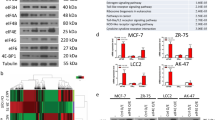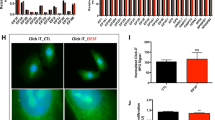Abstract
Altered expression of the eukaryotic translation initiation factor 3 (eIF3) subunit eIF3e/INT6 has been described in various types of human cancer, but the nature of its involvement in tumorigenesis is not yet clear. Using immunohistochemical analysis of 81 primary breast cancers, we found that high tumor grade correlated significantly with elevated cytoplasmic eIF3e level in epithelial tumor cells. Analysis of protein synthesis after siRNA-mediated knockdown in breast cancer cell lines indicated that eIF3e is not required for bulk translation. Microarray analysis of total and polysomal RNAs nonetheless identified distinct sets of mRNAs regulated either positively or negatively by eIF3e; functional classification of these revealed a marked enrichment of genes involved in cell proliferation, invasion and apoptosis. Validated mRNA targets regulated positively at the translational level by eIF3e included urokinase-type plasminogen activator and apoptotic regulator BCL-XL, whereas synthesis of proteins including the mitotic checkpoint component MAD2L1 was negatively regulated. Finally, eIF3e-depleted breast carcinoma cells showed reduced in vitro invasion and proliferation. Taken together, our study data suggest that eIF3e has a positive role in breast cancer progression. It regulates the translation, and in some cases abundance, of mRNAs involved in key aspects of cancer cell biology.
This is a preview of subscription content, access via your institution
Access options
Subscribe to this journal
Receive 50 print issues and online access
$259.00 per year
only $5.18 per issue
Buy this article
- Purchase on Springer Link
- Instant access to full article PDF
Prices may be subject to local taxes which are calculated during checkout





Similar content being viewed by others
References
Ahlemann M, Zeidler R, Lang S, Mack B, Munz M, Gires O . (2006). Carcinoma-associated eIF3i overexpression facilitates mTOR-dependent growth transformation. Mol Carcinog 45: 957–967.
Asano K, Merrick WC, Hershey JW . (1997). The translation initiation factor eIF3-p48 subunit is encoded by int-6, a site of frequent integration by the mouse mammary tumor virus genome. J Biol Chem 272: 23477–23480.
Bandyopadhyay A, Matsumoto T, Maitra U . (2000). Fission yeast Int6 is not essential for global translation initiation, but deletion of int6(+) causes hypersensitivity to caffeine and affects spore formation. Mol Biol Cell 11: 4005–4018.
Benne R, Hershey JW . (1978). The mechanism of action of protein synthesis initiation factors from rabbit reticulocytes. J Biol Chem 253: 3078–3087.
Bramham CR, Wells DG . (2007). Dendritic mRNA: transport, translation and function. Nat Rev Neurosci 8: 776–789.
Bubendorf L, Nocito A, Moch H, Sauter G . (2001). Tissue microarray (TMA) technology: miniaturized pathology archives for high-throughput in situ studies. J Pathol 195: 72–79.
Buchsbaum S, Morris C, Bochard V, Jalinot P . (2007). Human INT6 interacts with MCM7 and regulates its stability during S phase of the cell cycle. Oncogene 26: 5132–5144.
Buratti E, Tisminetzky S, Zotti M, Baralle FE . (1998). Functional analysis of the interaction between HCV 5′UTR and putative subunits of eukaryotic translation initiation factor eIF3. Nucleic Acids Res 26: 3179–3187.
Buttitta F, Martella C, Barassi F, Felicioni L, Salvatore S, Rosini S et al. (2005). Int6 expression can predict survival in early-stage non-small cell lung cancer patients. Clin Cancer Res 11: 3198–3204.
Chen L, Uchida K, Endler A, Shibasaki F . (2007). Mammalian tumor suppressor Int6 specifically targets hypoxia inducible factor 2{alpha} for degradation by hypoxia- and pVHL-independent regulation. J Biol Chem 282: 12707–12716.
Crane R, Craig R, Murray R, Dunand-Sauthier I, Humphrey T, Norbury C . (2000). A fission yeast homolog of Int-6, the mammalian oncoprotein and eIF3 subunit, induces drug resistance when overexpressed. Mol Biol Cell 11: 3993–4003.
Dennis Jr G, Sherman BT, Hosack DA, Yang J, Gao W, Lane HC et al. (2003). DAVID: database for annotation, visualization, and integrated discovery. Genome Biol 4: P3.
Dong Z, Zhang JT . (2006). Initiation factor eIF3 and regulation of mRNA translation, cell growth, and cancer. Crit Rev Oncol Hematol 59: 169–180.
Grzmil M, Whiting D, Maule J, Anastasaki C, Amatruda JF, Kelsh RN et al. (2007). The INT6 cancer gene and MEK signaling pathways converge during zebrafish development. PLoS One 2: e959.
Han B, Nakamura M, Mori I, Nakamura Y, Kakudo K . (2005). Urokinase-type plasminogen activator system and breast cancer (review). Oncol Rep 14: 105–112.
Hinnebusch AG . (2006). eIF3: a versatile scaffold for translation initiation complexes. Trends Biochem Sci 31: 553–562.
Holcik M, Sonenberg N . (2005). Translational control in stress and apoptosis. Nat Rev Mol Cell Biol 6: 318–327.
Jivotovskaya AV, Valasek L, Hinnebusch AG, Nielsen KH . (2006). Eukaryotic translation initiation factor 3 (eIF3) and eIF2 can promote mRNA binding to 40S subunits independently of eIF4G in yeast. Mol Cell Biol 26: 1355–1372.
Lopez de Quinto S, Lafuente E, Martinez-Salas E . (2001). IRES interaction with translation initiation factors: functional characterization of novel RNA contacts with eIF3, eIF4B, and eIF4GII. RNA 7: 1213–1226.
Mack DL, Boulanger CA, Callahan R, Smith GH . (2007). Expression of truncated Int6/eIF3e in mammary alveolar epithelium leads to persistent hyperplasia and tumorigenesis. Breast Cancer Res 9: R42.
Marchetti A, Buttitta F, Miyazaki S, Gallahan D, Smith GH, Callahan R . (1995). Int-6, a highly conserved, widely expressed gene, is mutated by mouse mammary tumor virus in mammary preneoplasia. J Virol 69: 1932–1938.
Marchetti A, Buttitta F, Pellegrini S, Bertacca G, Callahan R . (2001). Reduced expression of INT-6/eIF3-p48 in human tumors. Int J Oncol 18: 175–179.
Mavrakis KJ, Wendel HG . (2008). Translational control and cancer therapy. Cell Cycle 7: 2791–2794.
Mayeur GL, Hershey JW . (2002). Malignant transformation by the eukaryotic translation initiation factor 3 subunit p48 (eIF3e). FEBS Lett 514: 49–54.
Merrick WC . (1979). Evidence that a single GTP is used in the formation of 80 S initiation complexes. J Biol Chem 254: 3708–3711.
Michel LS, Liberal V, Chatterjee A, Kirchwegger R, Pasche B, Gerald W et al. (2001). MAD2 haplo-insufficiency causes premature anaphase and chromosome instability in mammalian cells. Nature 409: 355–359.
Minn AJ, Rudin CM, Boise LH, Thompson CB . (1995). Expression of bcl-xL can confer a multidrug resistance phenotype. Blood 86: 1903–1910.
Miyazaki S, Imatani A, Ballard L, Marchetti A, Buttitta F, Albertsen H et al. (1997). The chromosome location of the human homolog of the mouse mammary tumor-associated gene INT6 and its status in human breast carcinomas. Genomics 46: 155–158.
Morris C, Jalinot P . (2005). Silencing of human Int-6 impairs mitosis progression and inhibits cyclin B-Cdk1 activation. Oncogene 24: 1203–1211.
Paquin N, Chartrand P . (2008). Local regulation of mRNA translation: new insights from the bud. Trends Cell Biol 18: 105–111.
Rasmussen SB, Kordon E, Callahan R, Smith GH . (2001). Evidence for the transforming activity of a truncated Int6 gene, in vitro. Oncogene 20: 5291–5301.
Rencus-Lazar S, Amir Y, Wu J, Chien CT, Chamovitz DA, Segal D . (2008). The proto-oncogene Int6 is essential for neddylation of Cul1 and Cul3 in Drosophila. PLoS One 3: e2239.
Saal LH, Troein C, Vallon-Christersson J, Gruvberger S, Borg A, Peterson C . (2002). BioArray Software Environment (BASE): a platform for comprehensive management and analysis of microarray data. Genome Biol 3: software0003.1–software0003.6.
Savinainen KJ, Helenius MA, Lehtonen HJ, Visakorpi T . (2006). Overexpression of EIF3S3 promotes cancer cell growth. Prostate 66: 1144–1150.
Siridechadilok B, Fraser CS, Hall RJ, Doudna JA, Nogales E . (2005). Structural roles for human translation factor eIF3 in initiation of protein synthesis. Science 310: 1513–1515.
Sotillo R, Hernando E, Diaz-Rodriguez E, Teruya-Feldstein J, Cordon-Cardo C, Lowe SW et al. (2007). Mad2 overexpression promotes aneuploidy and tumorigenesis in mice. Cancer Cell 11: 9–23.
Thumma SC, Kratzke RA . (2007). Translational control: a target for cancer therapy. Cancer Lett 258: 1–8.
Traicoff JL, Chung JY, Braunschweig T, Mazo I, Shu Y, Ramesh A et al. (2007). Expression of eIF3-p48/INT6, TID1 and Patched in cancer, a profiling of multiple tumor types and correlation of expression. J Biomed Sci 14: 395–405.
Udagawa T, Nemoto N, Wilkinson CR, Narashimhan J, Jiang L, Watt S et al. (2008). Int6/eIF3e promotes general translation and Atf1 abundance to modulate Sty1 MAPK-dependent stress response in fission yeast. J Biol Chem 283: 22063–22075.
von Arnim AG, Chamovitz DA . (2003). Protein homeostasis: a degrading role for Int6/eIF3e. Curr Biol 13: R323–R325.
Watkins SJ, Norbury CJ . (2002). Translation initiation and its deregulation during tumorigenesis. Br J Cancer 86: 1023–1027.
Watkins SJ, Norbury CJ . (2004). Cell cycle-related variation in subcellular localization of eIF3e/INT6 in human fibroblasts. Cell Prolif 37: 149–160.
Wendel HG, Silva RL, Malina A, Mills JR, Zhu H, Ueda T et al. (2007). Dissecting eIF4E action in tumorigenesis. Genes Dev 21: 3232–3237.
Winters ZE, Hunt NC, Bradburn MJ, Royds JA, Turley H, Harris AL et al. (2001). Subcellular localisation of cyclin B, Cdc2 and p21(WAF1/CIP1) in breast cancer association with prognosis. Eur J Cancer 37: 2405–2412.
Yen HC, Gordon C, Chang EC . (2003). Schizosaccharomyces pombe Int6 and Ras homologs regulate cell division and mitotic fidelity via the pro. Cell 112: 207–217.
Zhang L, Pan X, Hershey JW . (2007). Individual overexpression of five subunits of human translation initiation factor eIF3 promotes malignant transformation of immortal fibroblast cells. J Biol Chem 282: 5790–5800.
Zhou C, Arslan F, Wee S, Krishnan S, Ivanov AR, Oliva A et al. (2005). PCI proteins eIF3e and eIF3m define distinct translation initiation factor 3 complexes. BMC Biol 3: 14.
Acknowledgements
We thank Ben Thomas and Sasha Akoulitchev for help and advice with 2D liquid chromatography, Cheng Han for help with the statistical analysis, Dan Scott and other members of the laboratory for their comments on the article. This work was supported by Cancer Research UK, the Association for International Cancer Research and the Wellcome Trust (through grant 075491/Z/04 to JR).
Author information
Authors and Affiliations
Corresponding author
Ethics declarations
Competing interests
The authors declare no conflict of interest.
Additional information
Supplementary Information accompanies the paper on the Oncogene website
Rights and permissions
About this article
Cite this article
Grzmil, M., Rzymski, T., Milani, M. et al. An oncogenic role of eIF3e/INT6 in human breast cancer. Oncogene 29, 4080–4089 (2010). https://doi.org/10.1038/onc.2010.152
Received:
Revised:
Accepted:
Published:
Issue Date:
DOI: https://doi.org/10.1038/onc.2010.152
Keywords
This article is cited by
-
Annexin A1 is a polarity cue that directs mitotic spindle orientation during mammalian epithelial morphogenesis
Nature Communications (2023)
-
Eukaryotic translation initiation factors as promising targets in cancer therapy
Cell Communication and Signaling (2020)
-
Roles of eIF3m in the tumorigenesis of triple negative breast cancer
Cancer Cell International (2020)
-
EIF3D promotes gallbladder cancer development by stabilizing GRK2 kinase and activating PI3K-AKT signaling pathway
Cell Death & Disease (2017)
-
Genetic Alterations of Chromosome 8 Genes in Oral Cancer
Scientific Reports (2014)



